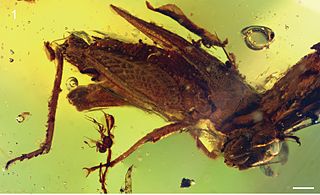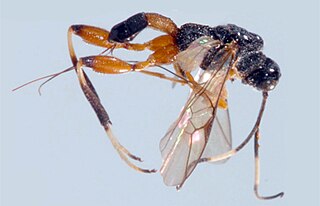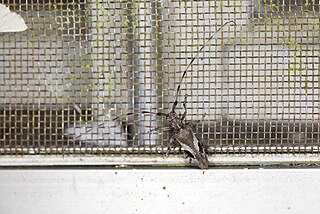
Thunbergia alata, commonly called black-eyed Susan vine, is a herbaceous perennial climbing plant species in the family Acanthaceae. It is native to Eastern Africa, and has been naturalized in other parts of the world.

Angustinaripterus was a basal pterosaur, belonging to the breviquartossan family Rhamphorhynchidae and discovered at Dashanpu near Zigong in the Sichuan province of China.

Nurhachius is a genus of istiodactylid pterodactyloid pterosaur from the Barremian to Aptian-age Lower Cretaceous Jiufotang Formation of Chaoyang, Liaoning, China. Its fossil remains date back about 120 million years ago.
Longchengpterus, sometimes misspelled as "Lonchengopterus", is a genus of istiodactylid pterodactyloid pterosaur from the Barremian-Aptian-age Lower Cretaceous Jiufotang Formation of Chaoyang, Liaoning, China. Its fossil remains dated back about 120 million years ago.

Liaoningopterus, sometimes misspelled as "Liaoningopteryx", was a genus of anhanguerid pterodactyloid pterosaur from the Barremian-Aptian-age Lower Cretaceous Jiufotang Formation of Chaoyang, Liaoning, China.

Callitris monticola, commonly known as the steelhead or dwarf cypress, is a species of conifer in the family Cupressaceae. It is found only in Australia, occurring in the states of Queensland and New South Wales and is considered vulnerable due to its restricted distribution.

Callitris muelleri is a species of conifer in the family Cupressaceae. It is found only in New South Wales, Australia.

Callitris rhomboidea, commonly known as the Oyster Bay pine, Tasmanian cypress pine, Port Jackson pine, Illawarra mountain pine, or dune cypress pine, is a species of conifer in the family Cupressaceae. It is native to Australia, occurring in South Australia, Queensland, New South Wales, Victoria and Tasmania. It has become naturalized near Auckland, New Zealand and can be found on the island of Taillefer Rocks in Tasmania.

Siamodon is an extinct genus of iguanodontian ornithopod dinosaur from Early Cretaceous deposits of northeastern Thailand.

Moganopterus is an extinct genus of ctenochasmatid pterosaur from the Early Cretaceous of western Liaoning Province, China.
Drosera peruensis is a carnivorous plant of the genus Drosera, commonly known as the Peruvian sundew. This Drosera species was first identified in Peru in 2002 by Tânia Regina dos Santos Silva and Mireya D. Correa following work to update the genus Drosera for the reference text, Flora Neotropica..

Pulveroboletus ravenelii, commonly known as Ravenel's bolete or the powdery sulfur bolete, is a species of bolete fungus in the family Boletaceae. Described as new to science in 1853, the widely distributed species is known from Asia, Australia, North America, Central America, and South America. Mycorrhizal with oak, the fungus fruits on the ground singly, scattered, or in groups in woods. Fruit bodies (mushrooms) have convex to flat, yellowish to brownish-red caps up to 10 cm (4 in) in diameter. On the cap underside, the pore surface is bright yellow before turning dingy yellow to grayish brown with age; it stains greenish blue then grayish brown after injury. A cottony and powdery partial veil remains as a ring on the stipe. The mushrooms are edible, and have been used in traditional Chinese medicine and for mushroom dyeing.

Electrotettix is an extinct genus of pygmy locust found in amber collected in the Dominican Republic. Represented by a single species, Electrotettix attenboroughi, which lived 18-20 million years ago, it fed primarily on moss, fungi, and algae. The genus name is derived from electrum, Latin for "amber", and Greek tettix, meaning "grasshopper". The species was named after Sir David Attenborough. The female measures 8 millimeters in length: the male is unknown. The species is distinguished from modern members of the Cladonotinae subfamily by the fact that it retains vestigial wings, a feature lost somewhere between the ancient specimens and more modern species. E. attenboroughi was identified from a collection of amber at the Illinois Natural History Survey, which had been stored in a cabinet under a sink since it was collected in the 1950s by entomologist Milton Sanderson.

Spasskia brevicarinata is a species of parasitoid wasp native to the Guizhou and Yunnan provinces of China. The female body is 8.2 millimeters long, with 7.3 millimeter forewings. The ovipositor, when fully extended, measures 5.5 millimeters long. General coloration is black, however, the first tergite is yellow. The fore and mid legs are also yellow, while the hind pair are reddish-brown and whitish-yellow. The antennae are dark brown, with a whitish-yellow stripe between the 11th and 15th flagellomeres No males of the species have been observed to date. The species name is derived from Latin brevi, meaning "short" and carinata, the word for "carina". This literally means that the species has a short dorsal carinae as part of the first tergite.

Asiablatta kyotensis, formerly in the genus Parcoblatta, is an endemic roach from Far Eastern Asia. On June 24, 1962, an unfamiliar male roach was captured in Kyoto City. This cockroach was an entirely unknown insect from Japan, and was later described as Parcoblatta kyotensis by Asahina in 1976.

Neoperla nigromarginata is a species of stonefly native to the Henan province of China. The forewing measures 11.8 millimeters in males, and 13.4–14.0 millimeters in females. The head is pale yellow to brown with black markings. Legs and antennae are brown. The species name refers to the dark-colored margins of the pronotum. The species is similar in many aspects to Neoperla flagellate and N. tuberculata, but can be distinguished by the size of the aedeagus. The Aedeagal sac and tube are approximately the same length, with the sac being membranous and covered in numerous small spines. A pair of flagella are discernable at the sac's apex.

Uraecha angusta is a species of beetle in the family Cerambycidae. It was described by Francis Polkinghorne Pascoe in 1856, originally under the genus Monohammus. It is known from Vietnam, China and Taiwan. It contains the varietas Uraecha angusta var. horishana.

Hypericum lancasteri, known as Lancaster's St. John's wort or as zhan e jin si tao in Chinese, is a species of flowering plant in the St. John's wort family Hypericaceae. The species has been awarded the Royal Horticultural Society's Award of Garden Merit.

Salix cheilophila is a shrub or small tree from the genus of willow (Salix) with initially tomentose hairy and later balding branches. The leaf blades have lengths of 2.5 to sometimes 6 centimeters. The natural range of the species is in China.

















